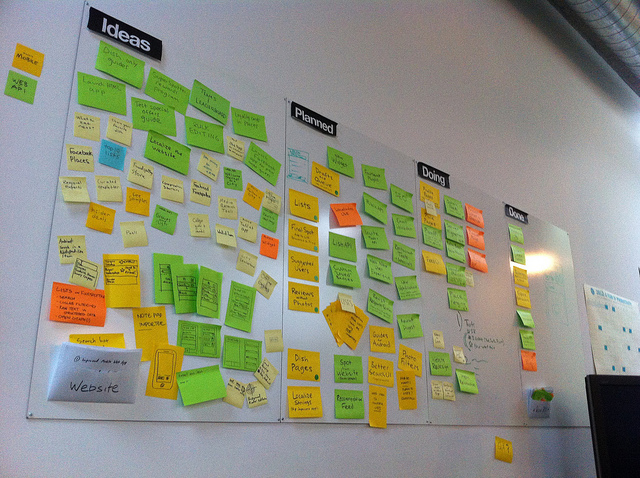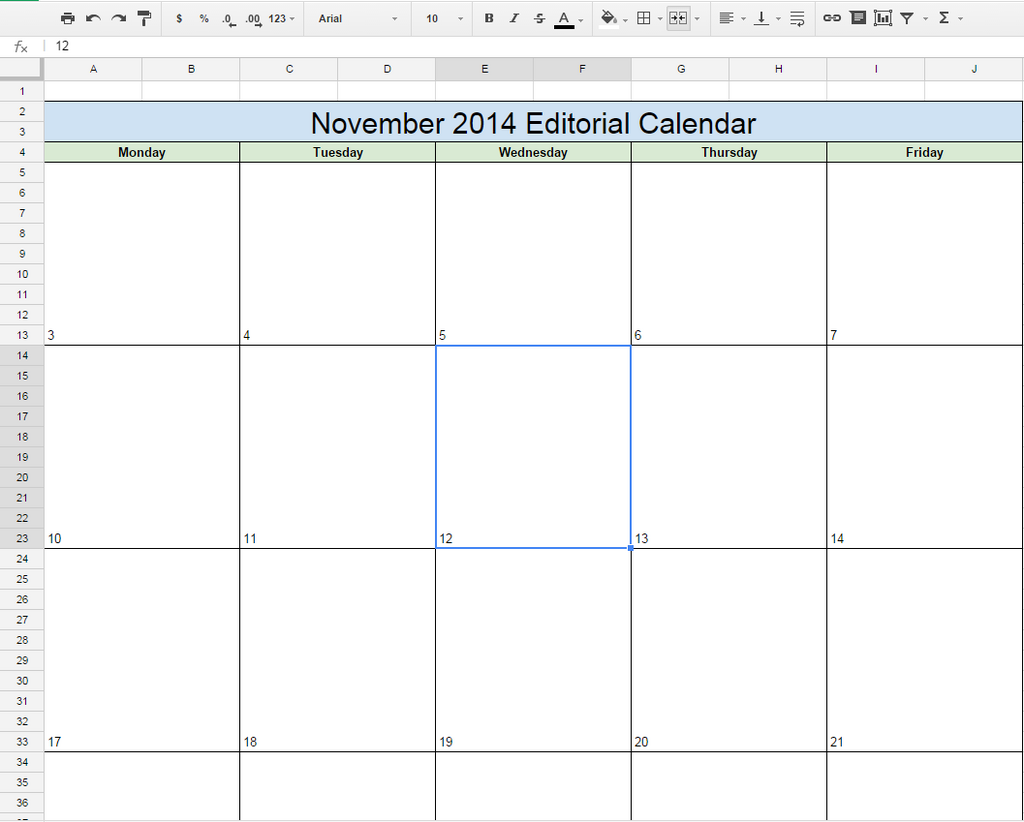Published December 16th 2014
How To Organise Content Creation Process: 18 Expert Tips
Content creation can be a daunting and laborious task. And it’s not just the actual act of writing an article, or designing a slideshow. But also the planning, research, and collaboration. If you work in a large company, or agency, this challenge is amplified 10-fold.
So how do we keep our content creation organized, and remain productive (other than beer and coffee)? I decided to ask 18 content marketing experts to tell us their process, including the tools they use. Here’s how the experts streamline their content creation process:
Here’s what they have shared:
- Keep a Brainstorming Google Doc and Evernote
- Track Topics with Mention and Pull Ideas Into Evernote
- Use 1 Tool (Asana) For Everything
- Use Trello To Create a Board For Each Buyer Persona
- Compile Your Best Content Ideas Once a Month
- Keep Track of Target Audience, and Keywords in a Spreadsheet
- Map Content Ideas Against Google Analytics
- Keep An Ongoing Content Ideas Board
- Share Performance Metrics in Monthly Meetings
- Use Spreadsheets to Track Dates and Titles
- Use Mind Maps and Scan Them As Projects Unfold
- Use Feedly To Stay Up To Date With Your Industry
- Plan With a 6 month Editorial Calendar
- Use Wunderlist + Evernote to stay organized
- Keep everything in an editorial calendar like DivvyHQ
- Have Weekly Meeting to Ensure Alignment
- Use Excel To Keep Track, and Trello To Collaborate
- Use Trello To Keep Track of Ideas
Keep a Brainstorming Google Doc and Evernote
At Search Engine Journal, we use EditFlow plugin on WordPress and Podio for the biggest projects. For my personal clients and content ideas, I have a brainstorming Google document and Evernote, depending on what I usually most work in with that particular client. To network and keep track of work with colleagues, I use Skype chat and Google Hangouts a lot, and at Search Engine Journal, we have a standing one hour conference call to cover any editorial news and projects. This helps keeps up on track. I also love using ToDoist to keep track of my own to-dos.
- Kelsey Jones, Managing Editor at Search Engine Journal
Track Topics with Mention and Pull Ideas Into Evernote
I track specific phrases and topics with Mention, and use Zapier to pull that into organized Evernote notes. From there, I review and create category breakdowns in our brainstorming spreadsheet, where I research similar posts and how well they performed (social metrics, organic metrics).
I use BuzzSumo during the social metrics and research portion for content, publishers and influencers, and Majestic SEO to pull backlinks/domain count. After that, I plan specific topics under each category and get pretty granular with what I’d like to include, other posts to reference, etc. I also look through my outreach research, relationships, etc during all of the aforementioned stages to see if there’s a potential partnership or collaboration opportunity that’ll be beneficial for both myself and an author/blogger/publisher. That’s a whole ‘nother beast though 🙂
I also plan out what kinds of assets I may need to design up (social assets) to assist in social promotion around that piece. The process around this varies depending on the client.
I’m testing out CoSchedule right now, which seems to be great for tying in content planning with your social editorial calendar. I can’t vouch for it 100% as I haven’t used it enough yet, but if you’re interested in checking it out: http://coschedule.com/
The Editorial Calendar plugin for WordPress has always been my go-to for planning out content.
I brainstorm once monthly with clients (or my own internal team) to plan for the following month. I never plan further than a quarter except for if we’re supporting a feature launch, focusing around a promotion/holiday, or extending a post with multiple parts or guides. This keeps us lean enough to adapt ideas.
- Selena Narayanasamy, Digital Strategy & SEO Consultant
Use 1 Tool (Asana) For Everything
As Paul Graham once said, “An obstacle downstream propagates upstream.” Create too much friction and you’ll stop having good ideas. For us, this friction was being caused by spreading out the planning process into a ton of apps. We now use Asana for everything.
We have profiles for each person involved (including our part-time editor) so that it’s easy to add to-do’s that keep everyone informed. The calendar feature shows how everything will be playing out over the coming months, making the somewhat scatterbrained job of a content creator a little more strategic.
We also have a folder called “Blog Pitches” where you can dump any idea you want with a short description — it’s a free for all in there, but in a good way. There are other folders for pieces that have made progress: things like “To be written” (once it’s approved) and “To be edited” (once the first draft is done). The one exception is outreach, which we prefer to keep track of in tools like Evernote; we have a separate content marketing notebook for anything too big to deal with in Asana.
Last but not least we have a quick “What are you doing this week?” meeting on Monday for 15 mins, and a one-on-one content call with our VP of Marketing and myself every Friday. HipChat and other tools are used to communicate throughout the week.
- Gregory Ciotti, Marketing at HelpScout
Use Trello To Create a Board For Each Buyer Persona
For us, stage one of the content planning process is coming up with ideas. Arguably too many ideas. We revisit our existing content to identify what’s been working, poke around on social media to see what people are talking about, and read a ton of articles to get the wheels turning.
We also hold a weekly content meeting where we bounce ideas off one another, hash out outlines, and talk shop.
From here, all of our ideas are filtered into our blogging Trello board. Trello is a highly visual project management app that is organized by “boards” and “cards.” We have individualized “boards” for each of our 3 buyer personas, so when we go to add an idea we’re forced to select a persona that it aligns with.
If it doesn’t meet the needs of our personas, we don’t move forward with it.
Trello also makes it really easy for us to collaborate with other team members. We can assign a “card” to someone, add a due date, create a to-do list, attach documents, and vote on ideas.
Compile Your Best Content Ideas Once a Month
I mainly use Google Docs to keep track of blog post ideas and planning at Wiser. I jot down ideas as they come and compile the best ones about once a month. When they are finalized, our Marketing Director and I generally order topics by how time sensitive they are and what is missing from our content library. From there, I build out a content schedule for at least the next month with the topic, posting date, name of the writer, and expertise needed. For longer form content, we manage rounds of edits using Asana, a task management tool.
Once we publish content, we use Buffer to schedule posts to promote it on our social sites. Buffer is connected with many employees’ LinkedIn accounts as well, so that we can stream-line social sharing within our networks. Articles that are posted on our blog are automatically sent out to all employees via MailChimp to keep the team updated. When we are featured on external websites, we send out company wide emails to inform our team and promote social sharing. After all, I believe that a company’s employees should be its biggest cheerleaders.
- Angelica Valentine, Content Marketing Manager at Wiser
Keep Track of Target Audience, and Keywords in a Spreadsheet
An organized and well maintained editorial calendar is absolutely essential to content planning. There are a number of helpful paid tools that make it easy and straightforward to set up an editorial calendar, but for a free option Google Docs is a viable choice.
You can use a Spreadsheet to set up a weekly calendar with each row representing a day of the week and each column dictating various key aspects of the content (i.e. target audience, target keywords, what makes the content unique/shareworthy, etc.). For example:
It’s also possible to create a more visual calendar that covers the whole month:
This format can be especially useful if you want to set up a relatively consistent and standardized posting schedule. For example, on Linkarati we have weekly content (Tutorial Tuesdays and Linkarati Roundups) that is featured every week so we can simply populate that into our editorial calendar each week – making content planning much easier.
- Andrew Dennis, Content Specialist at PageOnePower
Map Content Ideas Against Google Analytics
I start content planning with a clear picture of our executive team’s priority goals, a question mapping process and close attention to analytics. My Brafton team and I regularly reach out to a cross section of our teammates, clients and prospects to keep a pulse on what content will be truly useful for readers and the business. We map content ideas against numbers from Google Analytics, Marketo and social platforms that highlight where and how our existing media succeeds in gaining broader web traction and/or driving acquisition — we want to optimize each piece to its full potential! Social listening tools (like BuzzSumo) add a nice layer to the process, as well.
The strategy is step one of the plan, and execution is step two. My team works off of a detailed calendar shared with every stakeholder to outline intended goals, production deadlines and promotion plans for content.
- Katherine Griwert, Head of Marketing Content & Communications at Brafton
Keep An Ongoing Content Ideas Board
At Hello Innovation, we use a few different tools throughout our content planning process. Day to day, I personally keep track of content ideas that I come across through a Google Chrome bookmarking app called Dewey Bookmarks. Once a week, I will also go in and input each of these bookmarked ideas into an ongoing Content Ideas Mural.ly board where our content team can organize our ideas into different categories, themes , and types of content in a really easy-to-view way.
Once it is time to begin executing our content ideas, we input each approved idea into a custom Jira Agile Board, where team members are able to see if the project is in progress or blocked, who it is assigned to, when it’s due, etc. Each day, all members of the content and marketing teams also participate in stand-up meetings to discuss what we are working on that day, where we may need help from other team members, and what we have accomplished so far. These meetings help all members of the team stay in-the-know with our projects and encourage contribution, even if you are not assigned to a particular project.
- Rilee Chastain, Content Marketing Manager, Hello Innovation
Share Performance Metrics in Monthly Meetings
When I was managing 29 remote community managers who were each responsible for 7 blog posts per month, we used Kapost. This proved to be a great tool for planning, editing and publishing that volume of content.
To keep the team on track we had monthly content marketing meetings/conference calls where I shared performance metrics and highlighted 2-3 of the best performing posts. We also spent about 10 minutes on each call sharing tips and tools for better content creation.
When managing a smaller team of writers I use a shared Google spread sheet with a tab for each month’s content plan. We also track all the basic metrics like due date, publish date, writer, title, content type, other media, keywords, etc.
The Google doc is the easiest way I’ve found to easily collaborate with a team of writers on a platform they’re already familiar with. This system allows me to spend less time managing writers and more time analyzing the business results and doing long range content planning.
- Ken Horst, Mash Digital Marketing
Use Spreadsheets to Track Dates and Titles
For each of our clients and our own content marketing, organisation is obviously key. We write thousands of words every month and if we didn’t keep organised, it’d be pretty easy to trip up. The most important ‘tool’ is Excel: at the start of every month we make up a spreadsheet with posting dates, titles, target demos, and secondary titles, in case we decide to ditch an article topic. That spreadsheet will become our editorial calendar for that client. For new campaigns, we’ll do research to establish what competitors are doing, tone, brand voice, what the client wants to accomplish, who the target demographics are etc.
Once we’ve got all that figured out, we’ll start mapping ideas. We use Asana for team management and Dropbox as the go-to for file storage. Fairly standard!
The research phase is pretty tough as our clients are in a broad spectrum of industries. Keeping up to date on all of them is time-consuming! When we’re planning content we do a lot of brainstorming and mind-mapping, usually by hand with a pen and notepaper. Once we’ve got concrete ideas we’ll refine them with keyword research via Keyword Planner.
If a campaign is particularly detailed and involves multimedia and several social media platforms, we’ll use DivvyHQ to keep everything in check.
– Lisa Sills, Brave Media
Use Mind Maps and Scan Them As Projects Unfold
I am very traditional in the way I plan my content ideas out. I use good old fashioned offline mind maps and scan them in as a quick reference as projects unfold. I then open a Google Drive spreadsheet and create multiple tabs. One that plans the mediums and notes exactly when blog posts, infographics, videos, press releases and social media campaigns will be created, put live, and then shared. The other tabs are used to note themes and exact titles and there is also one for competitor research and current hot trends/themes in their industry/area.
The sharing process involves a syndication framework that is followed for every piece of content. Colleagues first, then outreach to relevant parties, each social media platform is noted and ticked off and if this is to be repeated the date and times of repetition are logged here. Google spreadsheets hold all of our correspondence so everyone has access to update progress and we hold regular face to face and Google hangout meetings with the content team to discuss fresh ideas and outreach opportunities to keep injecting momentum into the process.
- Jodie King, SEO Traffic Lab
Use Feedly To Stay Up To Date With Your Industry
I like to use Feedly to stay up to date with what’s going on in marketing, analytics and tech. I scroll through my profile when I have a free moment in my day to gather content ideas for myself and catch up on the latest news. I also rely heavily on my editorial calendar that helps me keep track of what articles I want to post when, as well as any other content I may have in mind for the each month.
I need to improve how I schedule my time around content. I tend to underestimate how much time each piece of content will take and all the facets to make it “go.” I manage two blogs (LocalVox and MarketMeSuite), and want to have articles posting on both of them steadily throughout the week. But with writing the articles, editing, getting another pair of eyes on them, scheduling them into WordPress, optimizing them with images and SEO, each article tends to take up more time than I like to think! But a simple checklist can help solve that issue quickly.
- Cami Bird, Head of Local Success at MarketMeSuite
Plan With a 6 month Editorial Calendar
We follow our famed content planning and ideation process to ensure we’re considering every single content opportunity (http://www.zazzlemedia.co.uk/ideation/).
Without this process to keep ideas on track and organised, brainstorms can very quickly become a free for all, rather than a chance to contribute ideas that are most suited to our clients key customers, and help them achieve their digital aims. BuzzSumo is a huge help throughout this process (and I’m not just saying that!)
Once we have a full list of ideas, it’s essential to plan these into a 6 month editorial calendar to ensure:
- There is good content flow
- Sufficient time is set aside to plan, create and outreach off page content
- We’re being pro-active rather than re-active to the clients own marketing plans and seasonal opportunities
- Social activity can be planned around the on-site content
We use Gdocs to track outreach activity, and a traffic light system to track individual activity.
Basecamp is used to track internal tasks and share documents (strategy, plans, etc) internally
- Jo Price, Zazzle Media
Use Wunderlist + Evernote to stay organized
I personally use Evernote and Wunderlist every single day. I am committed to planning my content goals and ensuring that I stay with my current strategy. I have found these two apps to be the most helpful with helping me stay on track and organized. Within our team, we communicate with Skype and Slack, and manage all of our projects and campaigns in Basecamp. Google Docs is used sometimes for collaborative projects and brainstorming.
- Ashlee Richards, Content Marketing Manager at CafePress
Keep everything in an editorial calendar like DivvyHQ
It involves a great deal of planning to keep the entire process streamlined. We use multiple tools like BuzzSumo, Evernote, and Gather Content to look-up for new content creation ideas. Everything is documented in an Editorial Calendar so that we can be on the same page with the rest of the team. DivvyHQ is one of the most-used tools in the entire process. We love it because it helps us simplify the work process, improve planning and collaborate & communicate across different silos.
Google Drive also comes handy all the time because of its ubiquity. We can save the documents and access them anytime, anywhere. To keep a track of outreach targets for each piece, we have our own CRM and of course the Google Spreadsheets. Trello and Co-schedule are two other tools that we use to manage content editorial.
I also recommend having a content production matrix created before you start generating content an then centrally manage everything. This way, we have a single source of data for what content is produced, when, and by whom.
- Navneet Kaushal, CEO at PageTraffic
Have Weekly Meeting to Ensure Alignment
We have a global content team, that’s generating touch points for customers throughout all stages of the SMB buying journey. Needless to say, organization is key to ensure we’re all on the same page. Each week we have an content editorial staff meeting to understand what everyone’s working on, and to align to the same messages and themes. For tools, Smart Sheet is indispensable – it’s a collaborative spreadsheet platform that allows for multiple contributors, file sharing and commenting. Hands down, it’s what keeps our editorial process on the rails.
Use Excel To Keep Track, and Trello To Collaborate
When working with clients, the tools vary based on what they’re already using when we jump in. Internally we use good, old fashioned Excel spreadsheets to keep track of the what/when/why/who and we use Trello to collaborate.
As an individual I could improve on how I keep track of my ideas. At any given point I might have thoughts in a notebook, on sticky notes and in a Word doc. When it’s time to discuss as a team I might miss an idea or have lost context on it.
Christin Kardos, Social Media At Bay Leaf Digital
Use Trello To Keep Track of Ideas
I do a lot of experiments with different tools and processes but my favorite tools are:
Trello – To keep track of what I need to do today, tomorrow and later. I note down everything in it and keep covering the pointers as planned. If an idea comes in my mind for a post and if the time is not right to get it done, I just store it in Trello and check back later. I also manage my routine tasks through Trello as it’s extremely easy to use and handy.
Dropbox – I don’t keep a lot of files in my local system as Dropbox seems to be working tremendously well in this case. I also store my content ideas in dropbox and share with my team as and when needed.
Google Spreadsheets – To keep track of the things I do, be it outreach campaigns or content planner, I rely on Google spreadsheets.
- Pratik Dholakiya, Founder of The 20 Media , a Content Marketing Agency Specializing in Content & Data-driven SEO and Preceptist, a SaaS Growth Marketing Agency
For other ways to optimize your content, check out our list of 30+ marketing and SEO chrome extensions that marketers are actually.
And get your 30-day free trial of BuzzSumo to reveal your content performance right now.
Categories
Content MarketingCategories
Content MarketingThe Monthly Buzz⚡
Subscribe to BuzzSumo's monthly newsletter to:
Stay up-to-date with the best of the best in content marketing 📝
Get data-informed content, tips and tidbits insights first 👩🏻💻
Read top shared content by top marketing geeks 🤓
Try
Enter any topic, term or url to search to see BuzzSumo in action. It’s free!
100% free. No credit card required.













